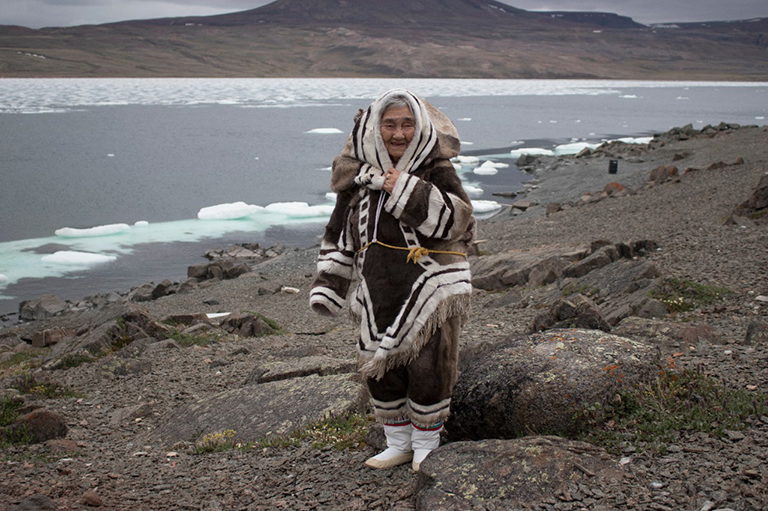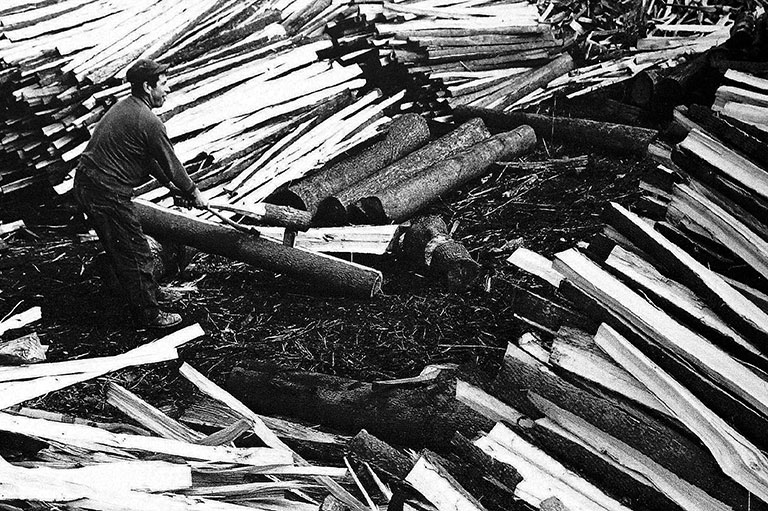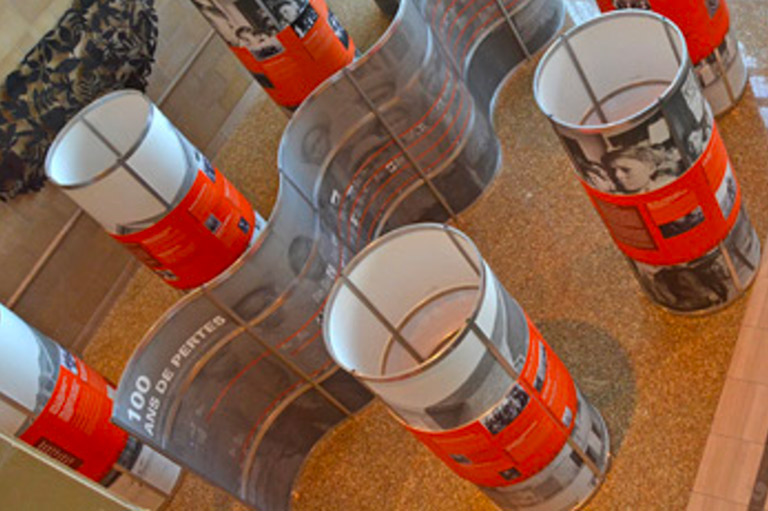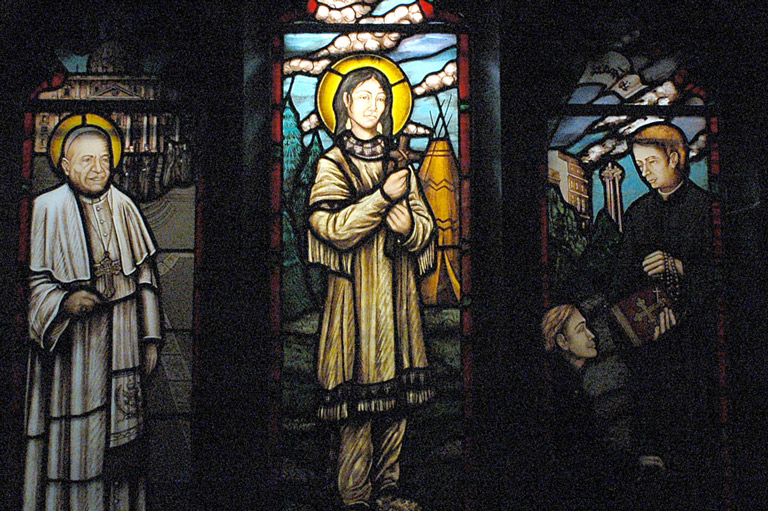Gaining Ground
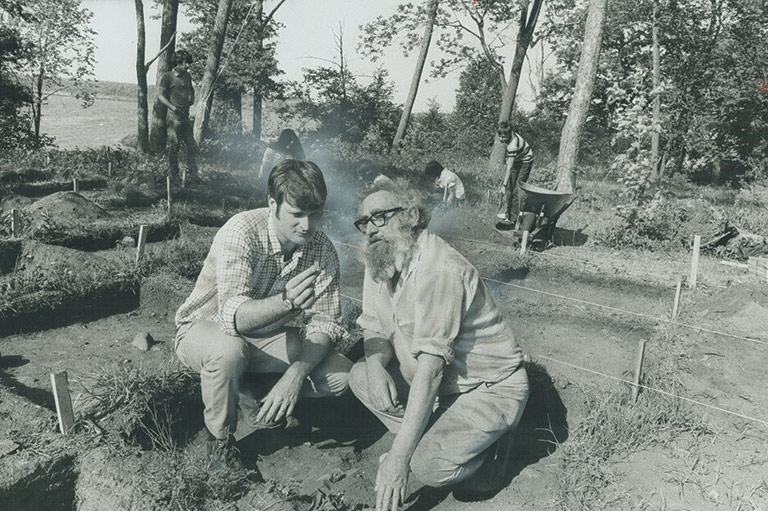
John Brown was returning to his Toronto home from a doctor’s appointment. His usual route along Withrow Avenue was disrupted, however, by a giant hole cut in the sidewalk to service a water pipeline. As Brown was trying to step around it, the ground beneath him gave way and he fell several feet.
While waiting for the construction crew to help him get out, he noticed something sticking out of the dirt. He pulled it out and threw it up top. “It could have been a branch for all I knew at the time, but it was sort of the wrong colour,” says Brown. “Once I got out of the hole, my only objective was to get home.”
A few weeks later, Brown’s wife, Eleanor, told him that ancient Indigenous remains had previously been discovered at the Withrow Avenue construction site and it dawned on him: It wasn’t a branch he had found — it was an ancient bone. His story was later reported in the Toronto Star.
The site of the discoveries was across the street from Withrow Avenue Junior Public School, a well-known archaeological site since 1886. The school itself sits atop land that was previously an Indigenous encampment and held cultural items and remains dating back approximately 5,000 years. An investigation was launched at the Withrow Avenue site, and construction halted. Soon, tents, fences and a city-hired security team were put in place to protect the remains throughout the investigation and negotiations with local First Nations.
With 7 uniquely curated newsletters to choose from, we have something for everyone.
That was in January 2024. While negotiations and investigations are still underway, Tanya Hill-Montour, archaeology supervisor for the Six Nations of the Grand River, told Global News the following September that not much action had been taken. At that point, the cost to protect the site had reached about $200,000. The investigation was initially delayed to allow the ground to thaw, but no further progress took place in the spring or summer of that year. Then, on March 6 of this year, the Toronto Star reported that the investigation had been stalled because the Haudenosaunee Confederacy Chiefs Council refused to sign off on the city’s proposed investigation plan.
The Haudenosaunee have oral and historical evidence that Withrow Avenue is a sacred spiritual site for their Nation going back thousands of years. As stakeholders, they have sent multiple written requests for a high level of oversight and engagement in the investigation. Aaron Detlor, a delegate with the Haudenosaunee Development Institute, told the Star that their requests include “a meeting with the mayor and senior city officials; a monitoring agreement over the site; an agreement with the city over Toronto Water projects in the area to ensure they don’t disturb any other remains; a site visit; and to work to set up a response plan.”
The Haudenosaunee Confederacy claims that the City of Toronto hasn’t responded to their letters or requests for involvement. After several months of delays, the tents and security are still protecting the site. Back in May, the Star reported that the costs for site protection had reached $340,000. If the City of Toronto continues to ignore the Haudenosaunee Confederacy Chiefs Council’s requests, the investigation won’t move forward.
Although urban development inadvertently leading to the discovery of ancient Indigenous remains isn’t a new phenomenon, the resulting investigations didn’t always look like this one. There generally wasn’t 24-hour security to protect the site or negotiations with the local First Nations. Rather, this is a stark contrast to how Indigenous historical and culturally sensitive sites have been treated for decades by archaeologists and local governments. Arriving at today’s practice, however, has its own dark history.

The mistreatment of Indigenous remains began in Canada’s early days of archaeological study. The first such recorded investigation took place near the Ottawa River in 1843, when Edward Van Cortlandt, a Victorian-era antiquarian, discovered an ancient burial ground. Randy Boswell, a journalism professor at Ottawa’s Carleton University who has done extensive research into the Parliament Hill excavations, and Jean-Luc Pilon, an archaeological researcher and the curator of central archaeology at the Canadian Museum of History, have research indicating that Van Cortlandt excavated the site at least twice between 1843 and 1860. However, the true location of these sites and of the Indigenous cultural items that Van Cortlandt took was lost for many years.
Although Van Cortlandt was one of the first people to excavate an Indigenous burial site for archaeological study, these sites have continued to be “discovered” and disturbed throughout the development of modern-day Canada. During the expansion of Victoria throughout the 1800s and into the 1900s, multiple gravesites were discovered, dug up and plundered by colonial settlers and archaeologists. The city itself was built upon one of the lands that held the remains of thousands of Lekwungen burial cairns. “The creation of a coast-to-coast Canada didn’t happen without the victimization of the people who were here first,” says Boswell.

Decades later, in October 1976, Lawson Allez was digging on a property just west of Centennial Park in Grimsby, Ont., when he discovered ancient cultural items and human remains. He called the Royal Ontario Museum (ROM) and, on Oct. 14, 1976, a team of archaeologists led by Walter Kenyon visited the site and began excavating the area nearby.
Work continued until Nov. 2, when the Union of Ontario Indians put Kenyon under citizen’s arrest for failing to follow the provisions in the Cemetery Act, which prohibited the disturbance of a grave without an official sanction, and for offering an indignity to human remains. The site was closed for two months. In January, it reopened and excavations restarted after legal and political matters were apparently resolved: All parties had agreed that the remains were to be analyzed on site by a biological anthropologist, then reburied nearby. The cultural items were divided among the Six Nations and the ROM.
What happened in Grimsby, says archaeologist Ronald Williamson, was a wake-up call for Canadian archaeology to work in collaboration with First Nations, Inuit and Métis communities. While there were archaeologists, like Williamson, who were already doing just that, it was far from standard in a field with a long history of colonial ideological influence and a lack of industry requirements for Indigenous engagement and consent. The Grimsby events were also proof that Indigenous communities would not sit idly by while their ancestors were disturbed.
“It’s been a long road to collaboration,” says Williamson. “In the early 1990s, when I was mid-career, I was working with archaeologists from across Canada to write ethical guidelines for proper relationships with Indigenous people.” These guidelines attempted to push the field to adopt informed consent. At the time, though, Williamson says there weren’t only archaeologists who were opposed but also stakeholders and professionals in construction and urban expansion industries.
Advertisement
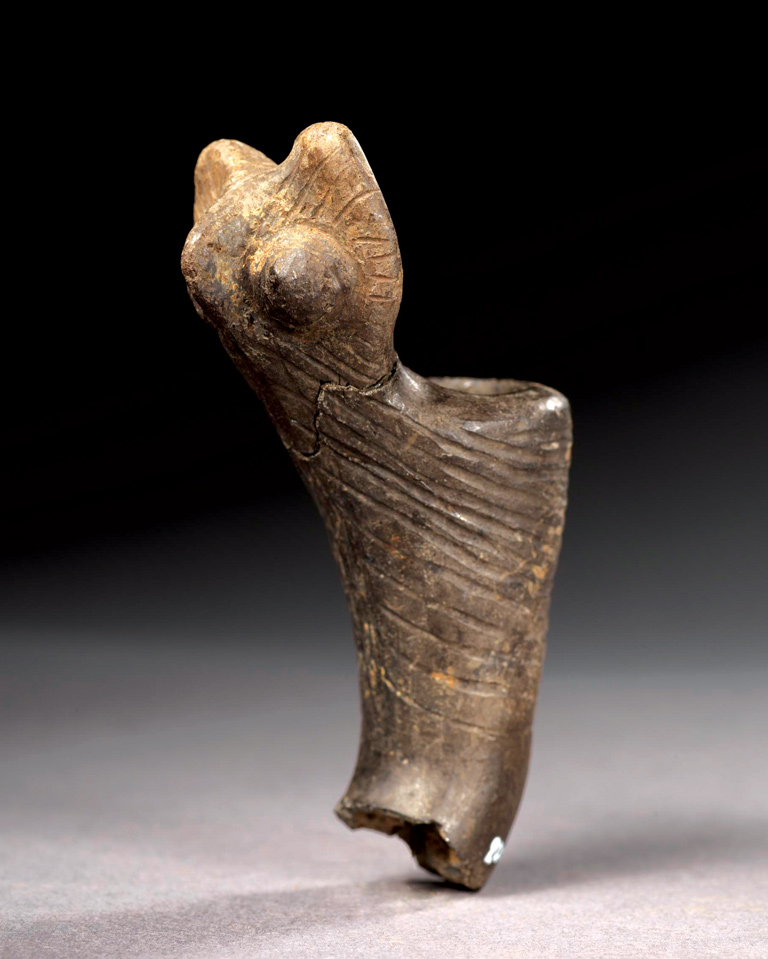
Still, in 1992, the Canadian Archaeological Association mandated the involvement of Indigenous Peoples on historically pertinent sites. “That’s when people started to really collaborate, because they were told by their profession you should,” says Williamson. And so began the path toward collaboration and consent from the First Nations communities.
Provincial standards have also mandated First Nations consultations. The 2011 Ministry of Tourism and Culture guidelines and standards for consultant archaeologists states that any fieldwork approaching stage four — where the entire site is excavated through one-by-one metre squares — must engage with local First Nations to ensure proper mitigation.
According to the guidelines, “the process demonstrates respect for Aboriginal heritage, recognizes Aboriginal peoples’ connection to the land, and allows everyone to benefit from their knowledge.”
Because of this, the presence of on-site First Nations experts and monitors has steadily increased. Adam LaForme, manager of archaeology for the Mississaugas of the Credit First Nation, in the department of consultation and accommodation, says that they have signed about 300 participation agreements for archaeological assessments within the past two years.
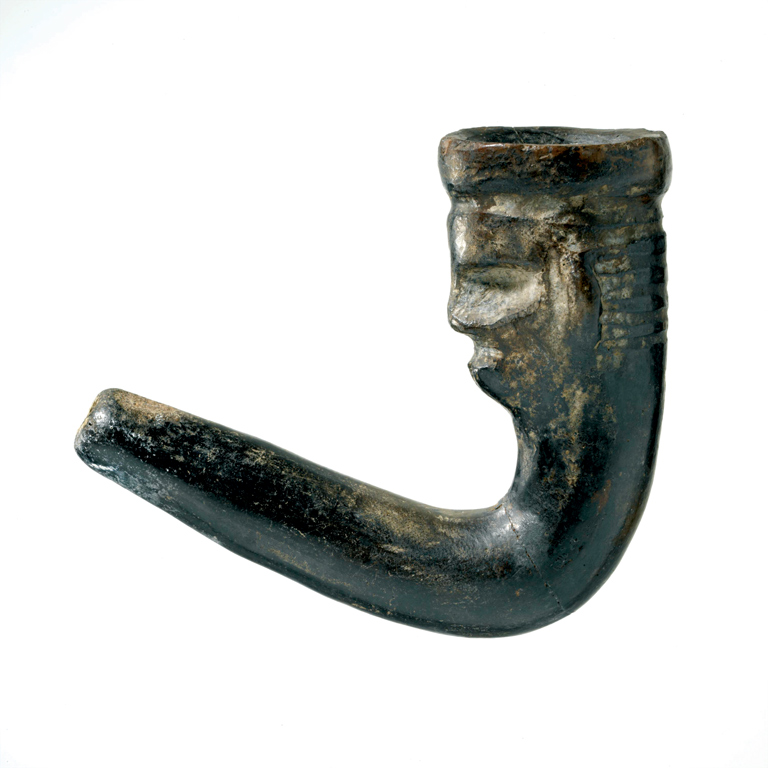
Indigenous Peoples are not the only ones who have benefited from these mandated changes — Canadian archaeology has, too. Increased Indigenous presence ensures more accurate assessments of history and any items or remains. It also helps ensure that ancestral remains are treated with dignity and respect.
In LaForme’s work, whenever ancestral remains are found, all of the local First Nations get a notification from Dr. Dirk Huyer, the chief coroner of Ontario, after he ensures that the remains aren’t related to any forensic interests — such as an unsolved murder or a missing-persons case. And there are some burial and archaeological sites where multiple First Nations come together to help.
“It’s incredibly rewarding to do so if you know your history,” says LaForme. “We have Six Nations, Huron-Wendat and the Mississaugas, all on one site, all collaborating toward a common goal. The Nations are the ones who are pretty much in the driver’s seat when it comes to burial-site investigations.”

Successfully increasing Indigenous Peoples’ autonomy over their ancestors has also required archaeology and museums to reconcile their historical harm. As part of that process, some sacred items and ancestral remains that were stolen from these communities have been returned — a process known as repatriation.
It’s difficult to pinpoint the first act of repatriation in Canada, but in 1978, the Canadian Museum of Civilization returned confiscated Potlatch items to communities in British Columbia’s Cape Mudge and Alert Bay. Over the next few decades, museums slowly adjusted and adopted the practice. One of the earliest repatriations of ancestral remains was in 1990, when the Royal British Columbia Museum in Victoria returned the remains of 23 Haida First Nation ancestors to their home community in Haida Gwaii in northern B.C. Over the next decade or so, the Haida People brought all 460 of their ancestors home from various museums across North America. Kwiaahwah Jones, a Haida artist who was previously a curator at the Haida Gwaii Museum, says that the Haida community has been ready for an increase in the number of sacred-item repatriations.
“We built a 57,000-square-foot complex to bring things home,” says Jones, adding that, so far, “we have repatriated all of our ancestors that we know of from the different institutions.” This was mostly due to the efforts of the Haida Nation, she adds, not because of voluntary decisions made by those institutions.
Still, the practice is showing promising results. The University of Toronto repatriated more than 1,500 ancestors to the Huron-Wendat First Nation. And in October 2019, the ROM returned to Rainy River First Nation ancestral remains it had held for about 30 years; those remains were the ones excavated in the late 1900s by Walter Kenyon — the man the Union of Ontario Indians placed under citizen’s arrest in 1976.
Save as much as 40% off the cover price! 4 issues per year as low as $29.95. Available in print and digital. Tariff-exempt!
A lot has changed in archaeology since Kenyon was practising — a path forward paved by Indigenous efforts. But there is still more work to be done, as Canada’s expanding urban landscapes will inevitably lead to the uncovering of more sacred Indigenous sites, and vigilance is key to prevent progress from backsliding.
In early June, the province of Ontario passed Bill 5: Protecting Ontario by Unleashing our Economy Act, committed to advancing even more infrastructure development and natural-resource extraction. On the federal level, expedited approval processes and fast-pacing economic projects are also being pushed through via Bill C-5: One Canadian Economy Act. Although both bills are positioned as tactical responses to the ongoing trade war with the U.S., there is a dark side — Bill 5 Schedule 7 alters the Ontario Heritage Act to give the province the power to exempt from archaeological assessment any property where infrastructure, houses and transit are being constructed. Bill C-5 grants the same kind of decision-making power at the federal level.
Scarlett Janusas, a retired marine archaeologist with the Ontario Marine Heritage Committee, told the CBC that archaeological assessments are a crucial part of protecting sacred sites, recording historical data and preserving cultural items. Another deeply concerning element is the impact this legislation has on consent and consultation with First Nations regarding development on their sacred historical sites (see “Bill 5 Pushback”).
Even before the passing of Bill 5, continued progress hasn’t been without challenges. Having consultants and staff on site is often quite costly for the Nations involved, while the ongoing urban expansion that uncovers these sites ultimately leads to financial benefits for all levels of government.
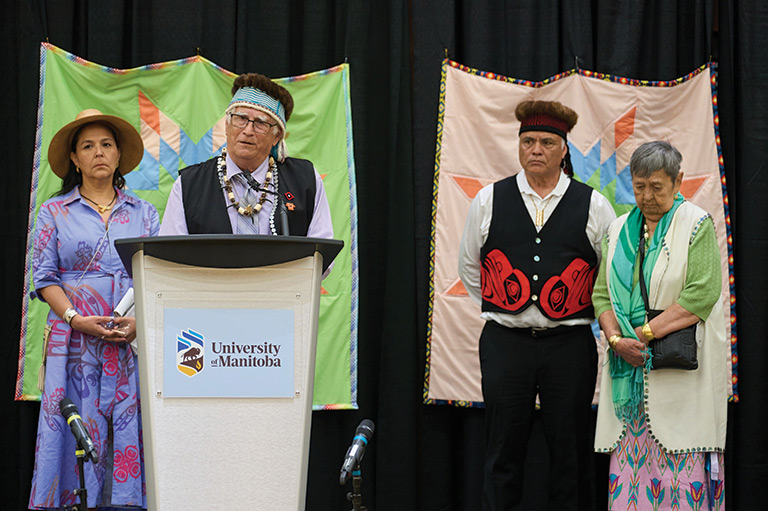
“The government should be paying for the Nations to be involved,” says LaForme, “whether it be archaeological or burial site investigations.” His assertion isn’t outside of the realm of possibility, especially considering that, as we went to press, security costs at the Withrow Avenue site were nearing $400,000 and discussions were ongoing.
Beyond costs, another barrier many of these communities face is the lack of Indigenous archaeologists. Having Indigenous representation on site for consultation and guidance is not the same as Indigenous-led investigations.
Some First Nations communities have already begun to take action to ensure that their people are the ones leading their communities’ archaeological affairs. In 2019, the Huron-Wendat Nation and ASI Heritage created Yändata’ Limited Partnership, which aims to recruit, train and encourage professional development by sharing archaeological knowledge and expertise with the Huron- Wendat Nation.
The development of companies like Yändata’ LP shows that the only way to continue to move forward is to build respectful relationships between First Nations and archaeologists. Through collaboration, archaeology in Canada will be increasingly led by Indigenous Peoples so that they can protect their cultural history, heritage and the story of their ancestors. As Laforme says, “It’s time for us to take the helm.”
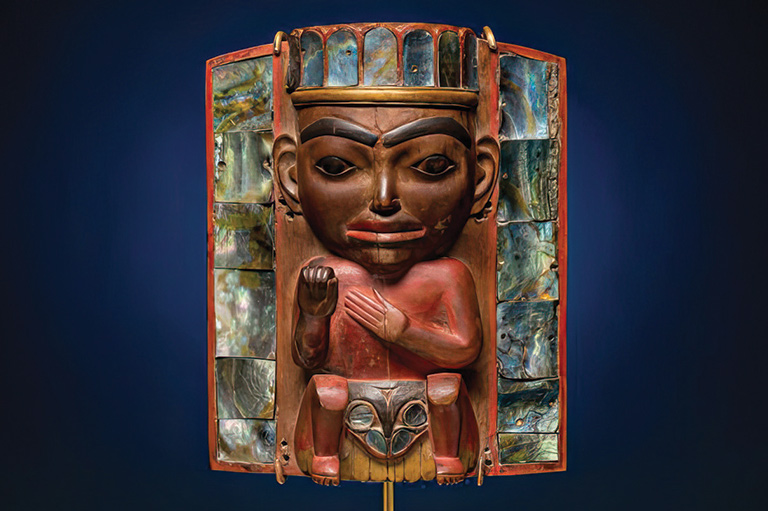
Advertisement
Bill 5 Pushback
Protecting Ontario by Unleashing our Economy Act may appear much as Ontario Premier Doug Ford positions it: a way to expedite infrastructure development and resource-extraction projects to protect the economy in the ongoing trade war with President Trump’s United States. Not only does this bill seem promising but it is also backed by the federal legislation Bill C-5: One Canadian Economy Act. It would seem that Canadian leaders are working together to establish stability in increasingly turbulent economic times.
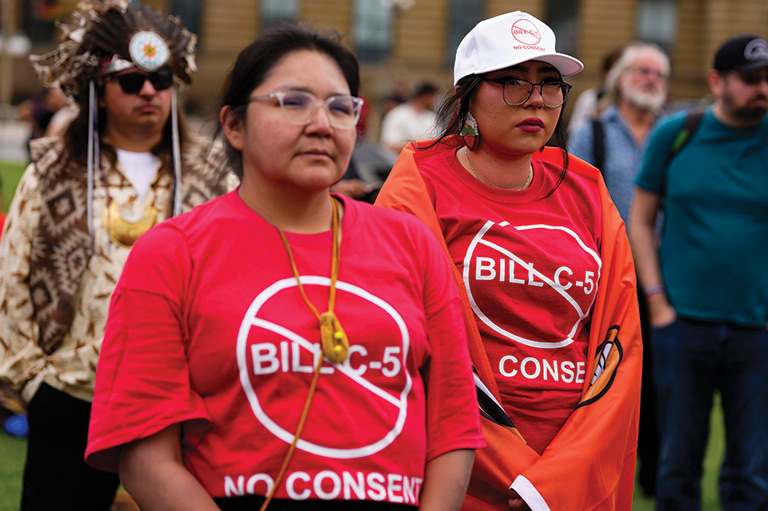
Critics, however, argue that these two omnibus bills prioritize short-term economic development over the longterm health of the water, environment, wildlife and future human generations. Bill 5 empowers the government to suspend provincial laws and regulations that protect endangered species and heritage sites; archaeological and environmental assessments; the oversight of mining; and the constitutionally protected rights of First Nations. Bill C-5 gives the federal government unprecedented power to approve and expedite projects of national interest. Prime Minister Mark Carney has promised that “consultation, cooperation, engagement, participation is at the heart of Bill C-5.” However, the written policy of the legislation fails to mention any of those conditions.
As a result, First Nations are pushing back against both pieces of legislation. “Our treaties are not red tape,” Alvin Fiddler, the Grand Chief of Nishnawbe Aski Nation, told the legislative assembly in May. On June 2, hundreds of First Nations leaders and protesters gathered at Queens Park to rally against Bill 5, demanding that Ford “kill the bill.” Failure to do so, Fiddler told APTN News, will result in a “long, hot summer” of protests. “We will not sit idly by and watch any government, whether it’s Ontario or Canada come to our territory and take whatever they want, because it’s ours.”
Canada's History magazine was established in 1920 as The Beaver, a Journal of Progress. In its early years, the magazine focused on Canada's fur trade and life in Northern Canada. While Indigenous people were pictured in the magazine, they were rarely identified, and their stories were told by settlers. Today, Canada's History is raising the voices of First Nations, Métis and Inuit by sharing the stories of their past in their own words.
If you believe that stories of Canada’s Indigenous history should be more widely known, help us do more. Your donation of $10, $25, or whatever amount you like, will allow Canada’s History to share Indigenous stories with readers of all ages, ensuring the widest possible audience can access these stories for free.
Any amount helps, or better yet, start a monthly donation today. Your support makes all the difference. Thank you!
Themes associated with this article
Advertisement






